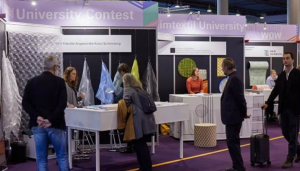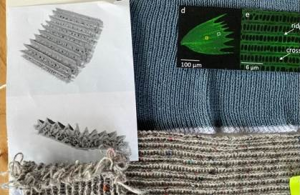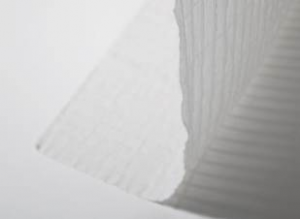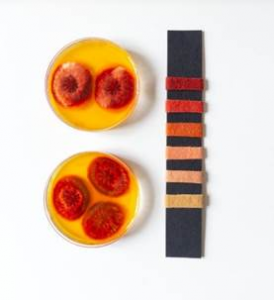![]() FRANKFURT AM MAIN, Germany — November 11, 2024 — The winners of the Heimtextil University Contest 2025 have been announced: Kateryna Basiuk, Eszter Nagy and Birke-Katharina Weber impressed with their clever textile solutions on the topics of light, sound protection and colour. In 2025, the contest received around twice as many submissions as last year. The selected projects can be seen at the world’s largest trade fair for home and contract textiles from 14 to 17 January 2025 in Frankfurt.
FRANKFURT AM MAIN, Germany — November 11, 2024 — The winners of the Heimtextil University Contest 2025 have been announced: Kateryna Basiuk, Eszter Nagy and Birke-Katharina Weber impressed with their clever textile solutions on the topics of light, sound protection and colour. In 2025, the contest received around twice as many submissions as last year. The selected projects can be seen at the world’s largest trade fair for home and contract textiles from 14 to 17 January 2025 in Frankfurt.
What textile solutions does the next generation have in store? The Heimtextil University Contest showcases the innovative power of young talents and universities at an international level. This is well received: 44 students from twelve countries submitted consistently high-quality projects for the current edition. The number of submissions has almost doubled compared to the University Contest 2024. The applications came from Germany, Finland, France, India, Lithuania, the Netherlands, Pakistan, Sweden, Switzerland, Slovakia, Slovenia and Ukraine. The winners have the opportunity to present their projects and universities to an international audience free of charge at Heimtextil 2025 in hall 3.0 and benefit from the global reach of the platform.

‘I am delighted that the Heimtextil University Contest has met with such a great international response. We can only solve transformations in networks that come together from diverse perspectives. That is why we are specifically promoting students and universities and focussing attention on them as drivers of innovation,’ says Bettina Bär, Director Heimtextil.
Heimtextil University Contest 2025 at a glance
In the international Heimtextil University Contest 2025, three winners asserted themselves with conceptually strong answers: Kateryna Basiuk (Lucerne University, Switzerland) is inspired by moth wings in ‘Silent Canvas’ and shows how recycled yarns work for aesthetically pleasing sound absorbers. Eszter Nagy (Aalto University, Finland) is focussing on the topic of light. Her ‘Lumen Collection’ centres on experimenting with woven textiles that navigate between light and space as membranes. And Birke-Katharina Weber (Weißensee Kunsthochschule Berlin, Germany) develops various possibilities for extracting sustainable dyes from mushrooms in her research project ‘MycoColors’.
The international expert jury is made up of six experts from relevant disciplines from academia and industry. This year’s members were: Svenja Bernhold, Laetitia Forst, Saman Khodabandeh, Tina Moor, Maarit Salolainen and Lutz Walter. Here you can find an overview of the jury members 2025.
The winners of the Heimtextil University Contest 2025
Kateryna Basiuk, Lucerne University, Switzerland – Silent Canvas

Photo — Kateryna Basiuk
In her project ‘Silent Canvas’, Kateryna Basiuk analyses how recycled yarns can be used for circular sound absorbers while improving their aesthetic and visual properties. She takes her inspiration from the sound-absorbing microstructures of moth wings. Her key technique for recreating these natural structures in recycled materials is knitting. The project addresses SDG 12.5, the reduction of waste generation through reuse. The work is part of a project of the Products & Textiles Research Group – HSLU Design, Film & Art.
Kateryna Basiuk: ‘Silent Canvas explores the relationship between aesthetics and acoustics through biomorphic design and recycled materials. Inspired by the structure of a moth’s wing and fuelled by a personal commitment to sustainable design solutions, I question traditional approaches and focus on new, circular processes. My journey began with a bachelor’s project at the Lucerne School of Art and Design in collaboration with the Product & Textile research group and has since led me deeper into the research field of sustainable textiles.’
Eszter Nagy, Aalto University, Finland – Lumen Collection

Photo — Eszter Nagy
Sustainability and light: In her ‘Lumen Collection’, Eszter Nagy presents textiles woven from natural materials that navigate as membranes between light and space. Her two main pieces were created on the industrial machine at Aalto University, which has a cotton warp. The density and thickness of the yarn led Eszter Nagy to test multi-layered structures and fil-coupe to increase light transmission. During the design process, she tried out hand-woven structures and treated them in different ways: In ‘Lilla’, she weaves a two-layer structure with linen wefts that reveal their long floats in the fabric when light falls on them. ‘Duo’ is created as a single fabric with a double weave, which is later cut apart using the fil-coupe technique. The pattern is woven with wool, which fixes the position of the cut wefts after washing and drying. The two fabrics created in this way form reciprocal negative patterns which, when laid on top of each other as a curtain, create a playful effect.
Eszter Nagy: ‘With my architectural background, I have always been fascinated by natural light and how it creates different spatial atmospheres. The starting point of the Lumen collection is experimenting with transparent textiles that navigate between light and space as a membrane. Lumen is also intended to be woven only from natural materials to demonstrate the sustainable possibilities of transparent fabrics. With each piece, the boundary between inside and outside is either more strongly defined or removed.’
Birke-Katharina Weber, Weißensee Kunsthochschule Berlin, Germany – MycoColors

Photo — Birke-Katharina Weber
‘MycoColors’ is dedicated to the colourful world of mushrooms: In her research work, Birke-Katharina Weber investigates innovative methods for extracting textile dyes from mushrooms, which have the potential to serve as an environmentally friendly alternative to synthetic dyes. Birke-Katharina Weber is researching different types of fungi and extraction processes in order to develop a wide range of sustainable colour options for the textile industry. Extractive processes for obtaining dyes from the fruiting bodies of existing fungal species and the controllable growth of mycelia in bioreactors are used for this purpose. Their aim is to create a constantly growing range of colours that can also be transferred to other materials.
Birke-Katharina Weber: ‘Our colourful planet has produced three large empires of organisms: flora, fauna and funga. Funga? In fact, the world of fungi is only partially visible to the eye in its diversity of form and function, but it is of fundamental importance for the formation and interaction of natural elements. Nowadays, it even offers numerous opportunities to stop the harmful and destructive dynamics of our industrial production methods.’
Posted: November 11, 2024
Source: Messe Frankfurt Exhibition GmbH




